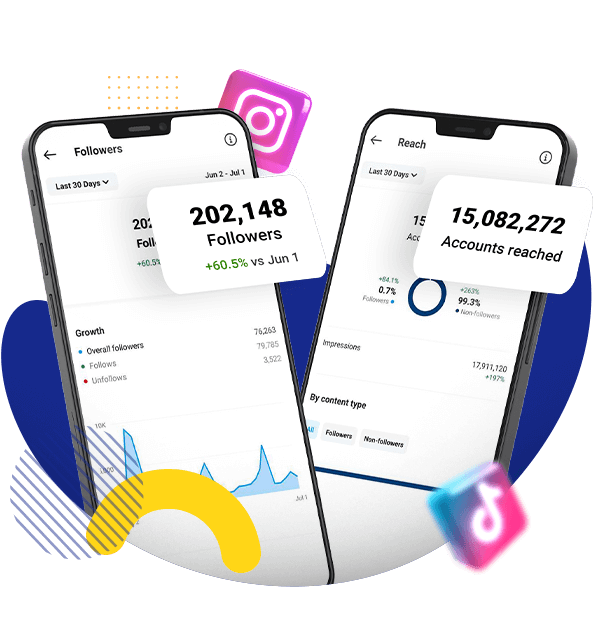Page Contents
For over a decade, social media has maintained a prime spot in every marketer’s mind, and email marketing was not very popular. As an accessible way of reaching potentially millions of customers across various content mediums, social media is an incredibly powerful tool to utilize. It would be nearly impossible to find a successful brand that doesn’t have at least one social media account, with most having one on every available platform.
Yet, while many marketers focus on social media due to its viral potential and instant exposure, this marketing method isn’t actually the highest when it comes to ROI. With 99% of users checking their email on a daily basis and email marketing generating $42 for every $1 spent, email marketing actually comes in on top.
Instead of favoring either email marketing or social media marketing, there’s a better way. By focusing on cohesive marketing – cross-platform strategies -, you’ll be able to make use of the personalization of email marketing and the high visibility of social media. In this article, we’ll break down absolutely everything you need to know about these marketing methods and dive into exactly how you can unify them for greater returns.
Let’s get started.
Why Is Cross-Platform Marketing So Important?
Successful brands are able to develop marketing strategies and campaigns that transcend singular platforms. By focusing on a singular platform, marketing teams are unable to reach the same volume of potential customers, limiting how effective their campaigns can be.
By focusing on cross-platform marketing, teams are set to achieve two core benefits. The first of these is that marketing teams can build a cohesive brand presence across many different platforms. Not only does this help with brand visibility, but it contributes to sustaining customer relationships and building authority in their niche.
Beyond this, cross-platform marketing also results in increased reach and improved customer engagement. Using multiple platforms gives businesses a much greater degree of flexibility. Not all customers are on certain platforms. Equally, some customers prefer receiving certain marketing materials on specific mediums.
Taking a cross-platform approach to marketing allows brands to build a holistic and highly-effective strategy for the future. As marketing continues to evolve and customer relationships become more dynamic, brands must evolve with them.
As leading platforms, social media and email should be at the top of every marketing team’s attention. Unifying these two particular strategies synergizes to facilitate the production of high-impact, high-reach, and high-conversion campaigns.
What Are the Benefits of Aligning Social Media and Email Marketing?
There is no denying the vast reach that social media contains. With countless platforms to choose from and billions of users around the world, social media can thrust your brand into the international spotlight. Email marketing, as a direct form of contact, is much more personal than social media.
By bringing these two communication channels together, your business is able to get the best of both worlds. A business that aligns social media and email marketing is set to gain a number of benefits:
- Diversify platforms for interaction – With more potential views across different platforms, your business is more likely to find new customers. You can unify all social media platforms with email in their own way, helping to create several new customer acquisition channels.
- Get more subscribers – Converting social media followers into email list subscribers can help to revitalize your email marketing strategy and increase engagement.
- Enhance marketing metrics – The more data, the better. Working across both email and social media data will allow you to find better actionable insights for your business to take on.
When you deliver high-quality content across both social media and email marketing channels, your audience will always be able to access useful content. Not only does this create customers that keep coming back for more, but you’ll also be defining yourselves as useful and visible brands going forward.
Connecting social media and email is one of the most powerful marketing tactics for 2023.
How To Unify Email Marketing and Social Media Marketing
In order to create cohesive marketing strategies, brands should aim to streamline their communication across all of their marketing channels. In order to do that, businesses should start at the lowest level possible. By pinpointing core brand elements like tone of voice, branding style, and communication methods, you’re able to then extend this across all social platforms.
There are four main areas that brands should explore when attempting to unify email marketing and social media marketing:
- Find your voice
- Unify Your Branding
- Dismantle Data Silos CRM and Data-Analysis
- Content Syndication Strategies
Let’s break these down further.
Find your voice
Tone of voice is one of the most overlooked parts of branding. If a business doesn’t have a clear style guide that covers all of your social, web, and messaging copy, your business will seem disjointed and unaligned. Without this in place, when you attempt to launch cross-platform connective marketing campaigns across email and social media, customers won’t react as well.
If your brand voice on social media is fun, down-to-earth, and energetic, then a dry and professional email will seem completely off. Not only does this call into question the validity of your campaign, but it can cause customers that follow you for your tone of voice to shy away from your brand.
The very first step you should take when developing unity between email marketing and social media marketing is to establish the tone of voice you’re going to lead with. Words will be your core method of communication, integrated into absolutely all content you put out. Although it may seem like a strange place to begin, finding your company voice is absolutely the best way of aligning multiple marketing channels going forward.
Unify Your Branding and Audience
Much like when attempting to find a core voice for your business, your brand should also create an extensive packet that demonstrates your branding. Beyond just your main company colors, this should cover things like your brand’s company values. Company values are vital for good branding. Once you’ve established what’s important to your brand, you can rapidly begin to pinpoint what sets you apart from other companies in your industry.
Finding these points where your brand does something different can be the key to good marketing. In fact, the vast majority of consumers are more likely to support brands that show opinions they agree with. By conducting research into the demographics and psychographics of those that follow you, you’ll be able to find new areas to use in your marketing campaigns.
Once you have a better idea of what you stand for and what your audience is looking for, you’ll be able to then start to produce this content for both your social media and email streams. As your audience will see a cohesive message across these social channels, you’ll then be able to reap the benefits of a strong brand message.
Don’t skip out on these early stages of branding – they’ll quickly convert into the most powerful part of your social media and email marketing strategy.
Dismantle Data Silos CRM and Data-Analysis
The most impactful change that marketing has seen over the past few decades has been the rise and total absorption of data-driven marketing techniques into the industry. Without a doubt, data-driven strategies are some of the most potent methods we can turn to in marketing. From boosting engagement to creating customized content that’s specifically built for your audience, analytics can always point us in the right direction.
Social media and email marketing both have a number of data tools that you can use. However, if you’re looking to truly unify both of these marketing streams, you should focus on using a CRM that brings these data pools together. Searching for a single source of truth will allow your business to pull data in from multiple sources.
Once you have all of your email and social media data in one place, you can start to build more efficient campaigns that actively feed into one another. Although these marketing streams are often treated as separate entities, pooling data from both into one system will allow you to manage both much more effectively.
2023 is all about removing data silos, dismantling roadblocks, and ensuring that you have complete data visibility.
Content Syndication Strategies
Finally, when building unity between email and social media marketing channels, it’s a good idea to bring yourself up to speed with content repurposing. Many people believe that by expanding the number of social channels you cover, you’re effectively giving your business more work. While this can be true, it doesn’t have to be.
Content repurposing is the process of recycling your marketing materials from one platform to another. If you’ve created a newsletter for email, you could take a core paragraph or insight and repurpose this into a social media post. Alternatively, you could display the entire newsletter in a chain of posts.
Content repurposing will quickly become your greatest asset in your journey to unify these streams. Not only does it reduce the amount of work it will take to run both social channels, but it will allow you to seamlessly blend from one platform to another. If customers feel like they can fluidly move from one platform to another, they’re going to be much more likely to do so.
Create synergy between your social streams by allowing your content to flow between marketing streams. Don’t think of them as completely different platforms, but rather two interlinked forces that bring customers to your company.
Effective Tips for Combining Email and Social Media Marketing
Once brands have aligned their fundamentals, they’re then able to rapidly connect email and social media content channels and experience all of the benefits that these fields can bring. In order to streamline the process, there are a number of tips that companies can use.
Here are some important tips and strategies to use when combining email and social media marketing:
- Email Signatures
- Cross-platform Promotion
- Use Pinterest as an Archive
Let’s break these down further.
Email Signatures
An email signature is much more than just an opportunity to share some information about an employee’s name and job title. In fact, this space is typically underutilized by marketing teams. In your email signature, you’re able to place icons for your social media pages. Not only does this increase the number of actions that a customer can take when engaging with your email, but you can help to build a direct link across platforms.
Cross-platform Promotion
Once your email signature is set up, you can also advance to more direct forms of moving traffic from social media to your email and vice versa. Be sure to have ample content that pushes customers from one stream to the other.
A great example of this is including links to your email newsletter on your social media page. By pulling specific insights from the newsletter, you can find new subscribers for your email newsletter. What’s more, you’re also able to send out day-before alerts telling your social media followers that an email newsletter is on the horizon.
Doing this can create a sense of urgency, helping to convert your social media followers to email subscribers.
Use Pinterest as an Archive
When people think of social media platforms, they mostly focus on Twitter, Instagram, Facebook, and TikTok. However, Pinterest is another visual platform that hosts a number of valuable opportunities for your business.
One way you can unify email and social media through Pinterest is by posting links to your achieved newsletters on that platform. Include a graphic or an exciting photo from the newsletter and then link your achieved newsletter to it. If people connect with the newsletter, they’ll be much more likely to sign up for the current one.
Just because a platform isn’t quite as popular, doesn’t mean that you should avoid it. Social media and email connections can come in many forms and on many distinct platforms.
Final Thoughts
Social media marketing is an incredibly powerful tool, especially when aligned with the equally as impressive email marketing. These two media streams have been leading the industry for years, with companies that align them being able to reach more customers, convert a higher percentage, and ensure streamlined customer-brand relationships.
By using the tips, strategies, and methods that we’ve outlined in this article, you’ll be able to create a holistic email and social media strategy. Across a better reach and more efficient communication, aligning these two fields is one of the best strategies a marketing team can take in 2023.






